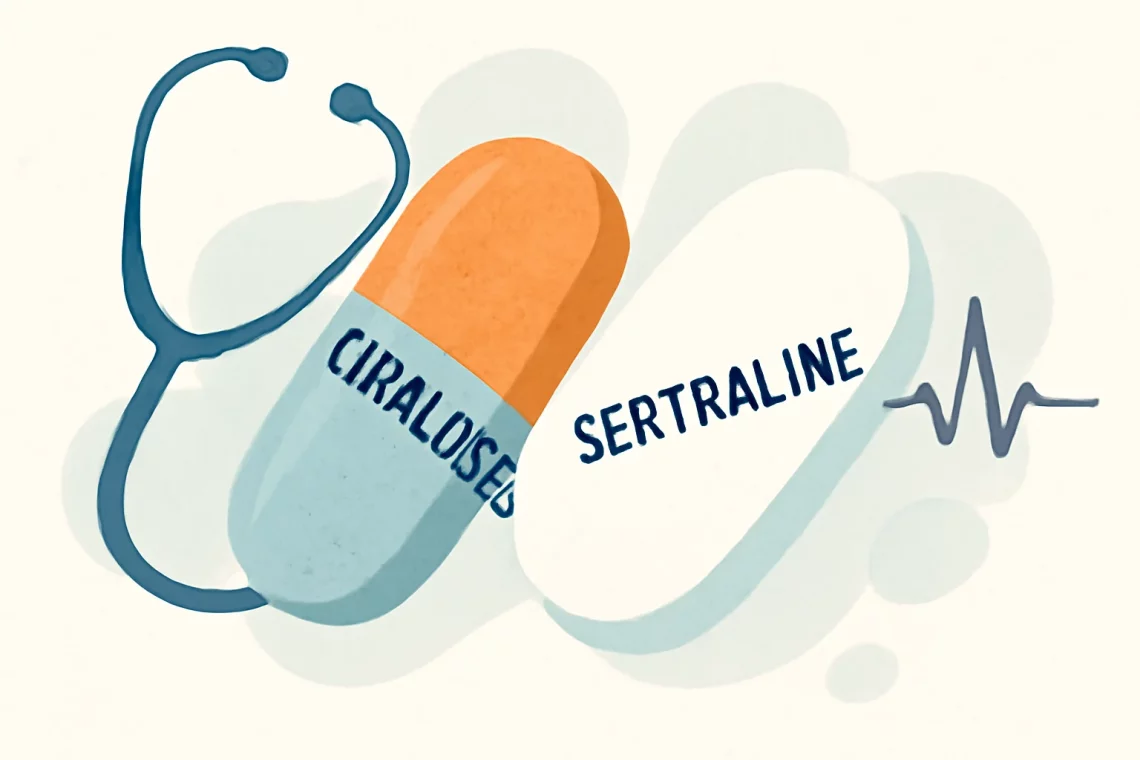
Citalopram vs Sertraline Which Antidepressant is Right for You
Citalopram and sertraline are two widely prescribed antidepressants that belong to the selective serotonin reuptake inhibitor (SSRI) class of medications. These drugs are primarily used to treat various forms of depression and anxiety disorders, offering relief to countless individuals struggling with these conditions. The increasing prevalence of mental health issues has led to a growing interest in understanding the effectiveness and differences between these two medications.
Both citalopram and sertraline work by increasing the levels of serotonin in the brain, a neurotransmitter that plays a crucial role in mood regulation. Despite their similar functions, they have distinct characteristics, side effects, and dosing regimens that can influence the choice of one over the other in clinical practice. Patients often find themselves weighing the benefits and drawbacks of each medication, seeking the most suitable option for their specific needs.
Understanding the nuances of citalopram and sertraline can empower patients to engage in informed discussions with their healthcare providers. Each individual’s experience with these medications can vary significantly, influenced by factors such as genetics, lifestyle, and the severity of their condition. Therefore, it is essential to delve deeper into the specifics of these two medications to make an educated choice.
Citalopram: Mechanism, Uses, and Side Effects
Citalopram is an SSRI that is commonly prescribed for the treatment of major depressive disorder and anxiety disorders. Its primary mechanism of action involves the inhibition of the serotonin transporter, which leads to increased serotonin levels in the synaptic cleft. This increase in serotonin availability is thought to enhance mood and alleviate symptoms of depression and anxiety.
In clinical settings, citalopram is typically administered in doses ranging from 10 to 40 mg per day. The dosage may be adjusted based on the patient’s response and tolerance. It is generally well-tolerated, but like any medication, it can cause side effects. Common side effects include nausea, dry mouth, fatigue, and sexual dysfunction. While these side effects can be bothersome, they are often temporary and may diminish over time as the body adjusts to the medication.
One significant consideration when prescribing citalopram is the potential for dose-dependent QT interval prolongation, which can lead to serious heart rhythm disturbances. Due to this risk, it is crucial for healthcare providers to monitor patients, particularly those with pre-existing heart conditions or those taking other medications that may affect heart rhythm.
Citalopram is also associated with a risk of withdrawal symptoms if discontinued abruptly. Patients are often advised to taper their dosage gradually under medical supervision to minimize these effects. Despite these potential drawbacks, many patients find citalopram to be an effective option for managing their symptoms, particularly when other treatments have failed.
Sertraline: Mechanism, Uses, and Side Effects
Sertraline is another popular SSRI that is frequently prescribed for a range of conditions, including major depressive disorder, obsessive-compulsive disorder (OCD), panic disorder, and post-traumatic stress disorder (PTSD). Similar to citalopram, sertraline works by selectively inhibiting the reuptake of serotonin, thereby increasing its availability in the brain.
The typical starting dose of sertraline is 50 mg per day, which can be adjusted based on the patient’s response. The medication can be taken with or without food, which adds to its convenience for many users.
While sertraline is generally well-received by patients, it does come with potential side effects. These can include gastrointestinal disturbances, insomnia, sexual dysfunction, and weight gain. Some patients may also experience increased anxiety or agitation when starting the medication, a phenomenon sometimes referred to as “activation.” This can be particularly concerning for individuals with anxiety disorders, as it may exacerbate their symptoms initially.
One notable advantage of sertraline is its relatively favorable side effect profile compared to other SSRIs. For example, it has a lower incidence of sedation and weight gain, making it an appealing choice for many patients. Nonetheless, as with citalopram, sudden discontinuation of sertraline can lead to withdrawal symptoms, necessitating a gradual tapering of the dosage.
Healthcare providers often consider sertraline for patients who may benefit from its broader spectrum of indications, including those with anxiety and OCD. It is essential for individuals to discuss their medical history and symptoms with their healthcare provider to determine whether sertraline is the right choice for them.
Comparative Effectiveness and Choosing the Right Medication
When it comes to choosing between citalopram and sertraline, several factors come into play, including the specific symptoms presented, the patient’s medical history, and the side effect profiles of each medication. While both medications are effective in treating depression and anxiety, their differing indications and side effects can guide the prescribing physician’s decision.
Research suggests that both citalopram and sertraline are effective for treating major depressive disorder, but there may be variations in efficacy based on individual patient characteristics. Some studies indicate that sertraline may be more effective for certain anxiety disorders, while citalopram may be preferred for those with predominant depressive symptoms.
Another important consideration is the side effect profile. Patients who are particularly sensitive to side effects may lean towards sertraline, given its reputation for having a more favorable tolerance. Conversely, those who have previously responded well to citalopram or who have specific concerns about weight gain or sedation may prefer citalopram.
Ultimately, the decision regarding which medication to prescribe should be a collaborative process between the patient and their healthcare provider. Open communication about past experiences with medications, current symptoms, and lifestyle factors can help in making the best choice for the individual. Regular follow-ups are also essential to assess the effectiveness of the chosen medication and make any necessary adjustments.
Patient Experiences and Considerations
Patient experiences with citalopram and sertraline can vary widely based on individual factors such as genetics, lifestyle, and the nature of their mental health condition. Many individuals report positive outcomes with both medications, experiencing significant improvements in mood and a reduction in anxiety symptoms. However, it is important to acknowledge that what works for one person may not work for another, and the journey to finding the right medication can involve trial and error.
Some patients may experience side effects that impact their quality of life, leading them to switch medications or adjust their dosages. Understanding that these reactions are common can help patients approach their treatment with realistic expectations. It is crucial for individuals to maintain open lines of communication with their healthcare providers, discussing any concerns or side effects they may experience.
Moreover, the role of non-pharmacological interventions, such as therapy or lifestyle changes, should not be underestimated. Many individuals find that combining medication with cognitive-behavioral therapy or other therapeutic approaches enhances their overall treatment outcomes. Engaging in regular physical activity, maintaining a healthy diet, and practicing mindfulness techniques can also contribute to improved mental health.
As patients navigate their treatment options, it’s essential to remember that mental health is a multifaceted issue that often requires a comprehensive approach. Collaboration with healthcare providers, ongoing education about their condition, and support from family and friends can significantly influence recovery and well-being.
**Disclaimer:** This article is for informational purposes only and should not be considered medical advice. Always consult with a healthcare professional before making any changes to your medication or treatment plan.




